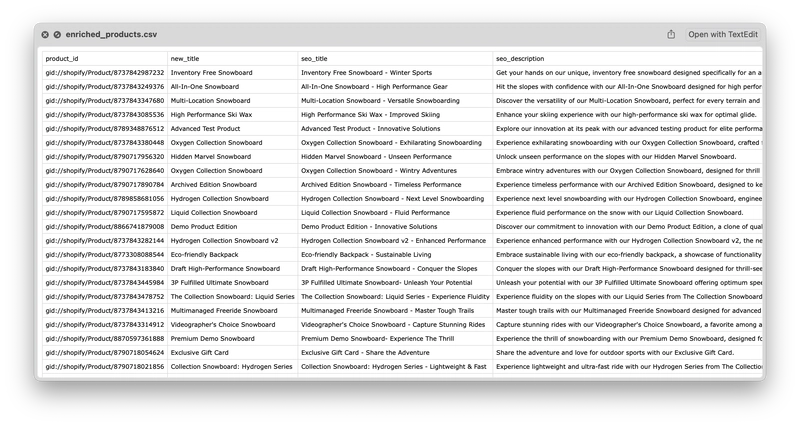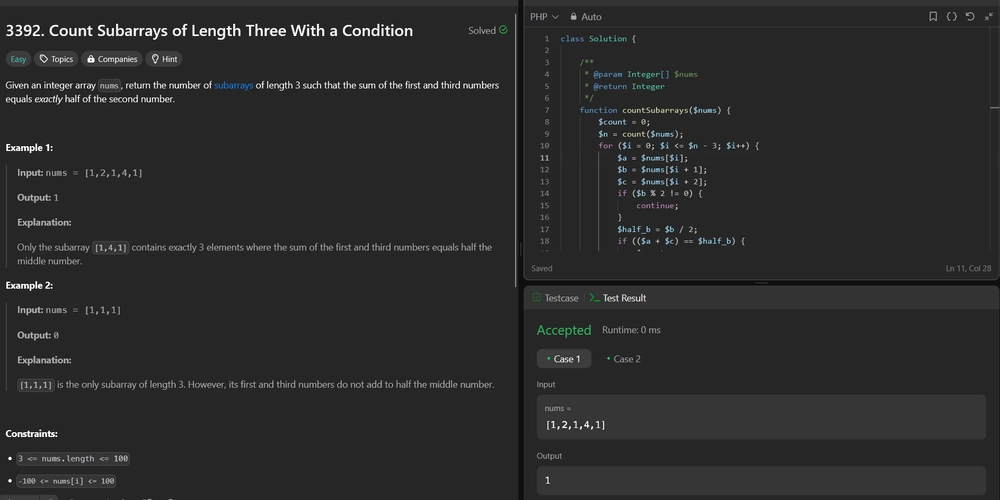How We Built an AI-Powered Automated Product Enrichment Pipeline for Shopify
Engineering a fully automated workflow for a Shopify store Maintaining a successful e-commerce store comes with its fair share of challenges. It demands constant attention to ever-changing details across inventory, customer experience, and platform updates. With so many moving parts, manual oversight can quickly become overwhelming, error-prone, and time-consuming. That’s where automation steps in — not just as a convenience but as a necessity to keep your store running efficiently and at scale. While Shopify offers a rich ecosystem of apps and drag-and-drop interfaces, it often requires you to trade transparency and control for convenience. TL;DR We’ll build a pipeline using GitHub Actions to export the latest products from the Shopify store, perform some actions using LLM, and update the products. Full source for the pipeline can be found here. Taking Back Control Let the robots worry about the boring stuff! Sooner or later, you will hit the limits with off-the-shelf apps and manual workflows and start looking for alternatives. One such alternative is to shift away from GUI-centric tools toward programmable pipelines that offer complete flexibility and control. What you want is: Full ownership of your data Enhancements tailored to your brand and products Sharable Workflows: multiple stores could use the same workflow with little to no tweak Confidence in every step of the process Now, let’s explore how we can build an automated CI pipeline to help mitigate the issues mentioned above. As a proof-of-concept, we’ll create a pipeline to streamline our product-content workflow. The pipeline will use LLM to review the latest products on our store, optimize the title, add SEO title and description, and generate a summary for the team to review. The Stack Here’s what powers the workflow: Shopify — where our products live GitHub Actions — for orchestration and automation ShopCTL — A command line utility for Shopify store management OpenAI API — to revise product titles, generate SEO content, and suggestions Python and some Bash scripts — for the enrichment logic and updates First things first — Setting up the stack Let’s start by setting up a GitHub Actions workflow. We’ll store pipeline configs in the .github/workflows/ directory. Create a file named enrich-products.yml inside the workflows directory. This file will define jobs for our product-content workflow. # .github/workflows/enrich-products.yml name: Shopify Product Enrichment on: workflow_dispatch: The workflow_dispatch event in GitHub Actions allows you to manually trigger a workflow from the GitHub interface or via the API , or you can schedule it to run automatically at a specific time. API Keys We’d need a few API keys to complete our configuration: OPENAI_API_KEY for AI operations and SHOPIFY_ACCESS_TOKEN to communicate with our store. Get the OpenAI API key from your OpenAI account and set it as a secret in GitHub. Getting a Shopify access token is tricky since you need to create a dummy app to do so. Follow this official guide to get one. ShopCTL We’ll use a command-line tool to export and update our products. Let’s create a custom action that we can reuse to reference in our pipeline. Create a file called setup-shopctl.yml inside actions directory and add the following config. # .github/workflows/actions/setup-shopctl.yml name: Setup ShopCTL description: Installs Go and ShopCTL CLI runs: using: "composite" steps: - name: Set up Go uses: actions/setup-go@v5 with: go-version: "1.24" - name: Install ShopCTL shell: bash run: | sudo apt-get update sudo apt-get install -y libx11-dev go install github.com/ankitpokhrel/shopctl/cmd/shopctl@main echo "$HOME/go/bin" >> "$GITHUB_PATH" Apart from custom actions, we need to add a configuration for the store we’re operating. Create a folder called shopctl on the repo’s root and add the following config in a file called .shopconfig.yml. Replace all occurrences of store1 with your store alias. # shopctl/.shopcofig.yml ver: v0 contexts: - alias: store1 store: store1.myshopify.com currentContext: store1 Finalizing the pipeline Our pipeline has four stages, viz: Export -> Enrich -> Update -> Notify Stage 1: Export products The first step in our pipeline is to export the latest products from our store. Add a job called export-products in the enrich-products.yml file we created earlier. jobs: export-products: runs-on: ubuntu-latest env: SHOPIFY_ACCESS_TOKEN: ${{ secrets.SHOPIFY_ACCESS_TOKEN }} # The secret we set earlier SHOPIFY_CONFIG_HOME: ${{ github.workspace }} # This will tell shopctl to use current dir to look for .shopconfig outputs: has-data: ${{ steps.check.outputs.has_data }} steps: - name: Checkout repo uses: actions/checkout@v3

Engineering a fully automated workflow for a Shopify store
Maintaining a successful e-commerce store comes with its fair share of challenges. It demands constant attention to ever-changing details across inventory, customer experience, and platform updates. With so many moving parts, manual oversight can quickly become overwhelming, error-prone, and time-consuming.
That’s where automation steps in — not just as a convenience but as a necessity to keep your store running efficiently and at scale. While Shopify offers a rich ecosystem of apps and drag-and-drop interfaces, it often requires you to trade transparency and control for convenience.
TL;DR
We’ll build a pipeline using GitHub Actions to export the latest products from the Shopify store, perform some actions using LLM, and update the products.
Full source for the pipeline can be found here.
Taking Back Control
Let the robots worry about the boring stuff!
Sooner or later, you will hit the limits with off-the-shelf apps and manual workflows and start looking for alternatives. One such alternative is to shift away from GUI-centric tools toward programmable pipelines that offer complete flexibility and control. What you want is:
- Full ownership of your data
- Enhancements tailored to your brand and products
- Sharable Workflows: multiple stores could use the same workflow with little to no tweak
- Confidence in every step of the process
Now, let’s explore how we can build an automated CI pipeline to help mitigate the issues mentioned above. As a proof-of-concept, we’ll create a pipeline to streamline our product-content workflow. The pipeline will use LLM to review the latest products on our store, optimize the title, add SEO title and description, and generate a summary for the team to review.
The Stack
Here’s what powers the workflow:
- Shopify — where our products live
- GitHub Actions — for orchestration and automation
- ShopCTL — A command line utility for Shopify store management
- OpenAI API — to revise product titles, generate SEO content, and suggestions
- Python and some Bash scripts — for the enrichment logic and updates
First things first — Setting up the stack
Let’s start by setting up a GitHub Actions workflow. We’ll store pipeline configs in the .github/workflows/ directory. Create a file named enrich-products.yml inside the workflows directory. This file will define jobs for our product-content workflow.
# .github/workflows/enrich-products.yml
name: Shopify Product Enrichment
on:
workflow_dispatch:
The workflow_dispatch event in GitHub Actions allows you to manually trigger a workflow from the GitHub interface or via the API , or you can schedule it to run automatically at a specific time.
API Keys
We’d need a few API keys to complete our configuration: OPENAI_API_KEY for AI operations and SHOPIFY_ACCESS_TOKEN to communicate with our store.
Get the OpenAI API key from your OpenAI account and set it as a secret in GitHub. Getting a Shopify access token is tricky since you need to create a dummy app to do so. Follow this official guide to get one.
ShopCTL
We’ll use a command-line tool to export and update our products. Let’s create a custom action that we can reuse to reference in our pipeline.
Create a file called setup-shopctl.yml inside actions directory and add the following config.
# .github/workflows/actions/setup-shopctl.yml
name: Setup ShopCTL
description: Installs Go and ShopCTL CLI
runs:
using: "composite"
steps:
- name: Set up Go
uses: actions/setup-go@v5
with:
go-version: "1.24"
- name: Install ShopCTL
shell: bash
run: |
sudo apt-get update
sudo apt-get install -y libx11-dev
go install github.com/ankitpokhrel/shopctl/cmd/shopctl@main
echo "$HOME/go/bin" >> "$GITHUB_PATH"
Apart from custom actions, we need to add a configuration for the store we’re operating. Create a folder called shopctl on the repo’s root and add the following config in a file called .shopconfig.yml. Replace all occurrences of store1 with your store alias.
# shopctl/.shopcofig.yml
ver: v0
contexts:
- alias: store1
store: store1.myshopify.com
currentContext: store1
Finalizing the pipeline
Our pipeline has four stages, viz: Export -> Enrich -> Update -> Notify
Stage 1: Export products
The first step in our pipeline is to export the latest products from our store. Add a job called export-products in the enrich-products.yml file we created earlier.
jobs:
export-products:
runs-on: ubuntu-latest
env:
SHOPIFY_ACCESS_TOKEN: ${{ secrets.SHOPIFY_ACCESS_TOKEN }} # The secret we set earlier
SHOPIFY_CONFIG_HOME: ${{ github.workspace }} # This will tell shopctl to use current dir to look for .shopconfig
outputs:
has-data: ${{ steps.check.outputs.has_data }}
steps:
- name: Checkout repo
uses: actions/checkout@v3
- name: Setup ShopCTL
uses: ./.github/workflows/actions/setup-shopctl
- name: Export products
run: |
mkdir -p data
# Export latest data (last 7 days) using the shopctl tool as latest_products.tar.gz
shopctl export -r product="created_at:>=$(date -v -7d +%Y-%m-%d)" -o data/ -n latest_products -vvv
- name: Check if export has data
id: check
run: |
if [ -s data/latest_products.tar.gz ]; then
echo "has_data=true" >> "$GITHUB_OUTPUT"
else
echo "has_data=false" >> "$GITHUB_OUTPUT"
echo "No products found to process"
fi
- name: Upload exported products
if: steps.check.outputs.has_data == 'true'
uses: actions/upload-artifact@v4
with:
name: exported-products
path: data/latest_products.tar.gz
The job above will set up ShopCTL using the custom action we created earlier. It will export all products created in the last 7 days and upload them as artifacts if any new products exist.
Stage 2a: Review catalog
The next we want to do is to review our catalog. We’ll use OpenAI API to review product data samples and identify the following:
- Issues or inconsistencies in tags, product types, or variants
- Missing or inconsistent inventory information
- Gaps in product configuration or variant structure
- Duplicate or overly similar products
- General recommendations to improve catalog quality and its completeness
review-catalog:
needs: export-products
runs-on: ubuntu-latest
env:
OPENAI_API_KEY: ${{ secrets.OPENAI_API_KEY }}
steps:
- name: Checkout repo
uses: actions/checkout@v3
- name: Download product export
uses: actions/download-artifact@v4
with:
name: exported-products
path: data/
- name: Set up Python
uses: actions/setup-python@v5
with:
python-version: "3.13"
- name: Install dependencies
run: pip install openai
- name: Run catalog review script
run: |
# Assuming your script is saved in scripts/review_catalog.py
python scripts/review_catalog.py \
data/latest_products.tar.gz \
data/review_summary.md
- name: Upload catalog summary
uses: actions/upload-artifact@v4
with:
name: catalog-review-summary
path: data/review_summary.md
- name: Final summary
run: echo "✅ Shopify product catalog review completed!"
Notice the needs section. We want to run it after products are exported and made available as artifacts. We also need to set up Python, as our review script is written in Python. You can use any language of your choice here. The script generates review_summary.md, which is uploaded as an artificat in the next step (example output below).
## Identified Issues
### 1. Missing or Inconsistent Information:
- Some products have missing or inconsistent `productType` (e.g. `"gid://shopify/Product/8790718087392"`, `"gid://shopify/Product/879071795632
The sample script and the prompt can be found here.
Stage 2b: Enrich Products
Similar to the review-catalog job, add an enrich-products job that will run the script to review the product title and generate an SEO title and description for the product using OpenAI. This job runs in parallel with the review catalog job and generates a CSV with details on metadata to update.
The sample script and the prompt can be found here.
Stage 3: Update products
Once the metadata is generated in stage 2b, we can update products using ShopCTL. We’ll use a bash script instead of Python at this stage.
Add a job called update-products, as shown below.
update-products:
needs: enrich-products
runs-on: ubuntu-latest
env:
SHOPIFY_ACCESS_TOKEN: ${{ secrets.SHOPIFY_ACCESS_TOKEN }}
SHOPIFY_CONFIG_HOME: ${{ github.workspace }}
steps:
- name: Checkout repo
uses: actions/checkout@v3
- name: Setup ShopCTL
uses: ./.github/workflows/actions/setup-shopctl
- name: Download enriched products
uses: actions/download-artifact@v4
with:
name: enriched-products
path: data/
- name: Apply updates using shopctl
run: |
mkdir -p logs
touch logs/audit.txt
while IFS=, read -r pid new_title seo_title seo_desc; do
# Strip leading/trailing quotes
seo_desc="${seo_desc%\"}"
seo_desc="${seo_desc#\"}"
# Use shopctl to update product details
if output=$(shopctl product update "$pid" \
--title "$new_title" \
--seo-title "$seo_title" \
--seo-desc "$seo_desc" 2>&1); then
echo "$pid,success" >> logs/audit.txt
else
sanitized_error=$(echo "$output" | tr '\n' ' ' | sed 's/,/ /g')
echo "$pid,failure,$sanitized_error" >> logs/audit.txt
fi
done < <(tail -n +2 data/enriched_products.csv)
- name: Upload audit log
uses: actions/upload-artifact@v4
with:
name: product-audit-log
path: logs/audit.txt
- name: Final summary
run: echo "✅ Shopify product enrichment and updates completed!"
The job is relatively simple; it uses a bash script to read from the CSV file generated in the previous step, update the product using ShopCTL, and create a log file.
Stage 4: Notify
Now, the only thing remaining is to notify interested parties that the job has been completed (or failed) and what has changed. You can either send a Slack notification or email the details. We will simply fetch and print the logs for the tutorial’s sake.
notify:
needs: [review-catalog, update-products]
runs-on: ubuntu-latest
steps:
- name: Download audit log
uses: actions/download-artifact@v4
with:
name: product-audit-log
path: logs/
- name: Download catalog review
uses: actions/download-artifact@v4
with:
name: catalog-review-summary
path: data/
- name: Print audit summary
run: |
ls -lah logs/
ls -lah data/
echo " 































































































































































![[The AI Show Episode 143]: ChatGPT Revenue Surge, New AGI Timelines, Amazon’s AI Agent, Claude for Education, Model Context Protocol & LLMs Pass the Turing Test](https://www.marketingaiinstitute.com/hubfs/ep%20143%20cover.png)































































































































![[DEALS] Koofr Cloud Storage: Lifetime Subscription (1TB) (80% off) & Other Deals Up To 98% Off – Offers End Soon!](https://www.javacodegeeks.com/wp-content/uploads/2012/12/jcg-logo.jpg)
























![Is this too much for a modular monolith system? [closed]](https://i.sstatic.net/pYL1nsfg.png)




















































































































_roibu_Alamy.jpg?width=1280&auto=webp&quality=80&disable=upscale#)





 CISO’s Core Focus.webp?#)




































































































![M4 MacBook Air Drops to Just $849 - Act Fast! [Lowest Price Ever]](https://www.iclarified.com/images/news/97140/97140/97140-640.jpg)
![Apple Smart Glasses Not Close to Being Ready as Meta Targets 2025 [Gurman]](https://www.iclarified.com/images/news/97139/97139/97139-640.jpg)
![iPadOS 19 May Introduce Menu Bar, iOS 19 to Support External Displays [Rumor]](https://www.iclarified.com/images/news/97137/97137/97137-640.jpg)





































































































